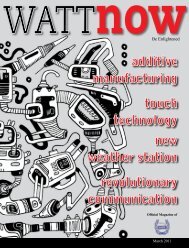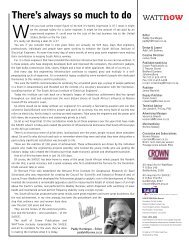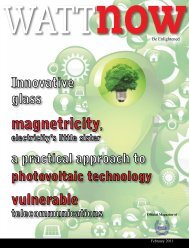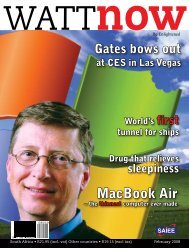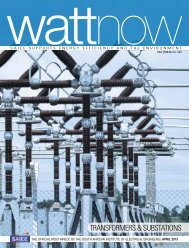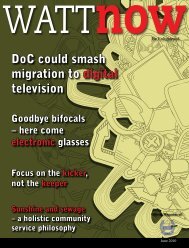Cut electricity consumption with automation - Watt Now Magazine
Cut electricity consumption with automation - Watt Now Magazine
Cut electricity consumption with automation - Watt Now Magazine
You also want an ePaper? Increase the reach of your titles
YUMPU automatically turns print PDFs into web optimized ePapers that Google loves.
The Texas instrument digital micro-mirror<br />
device consists of more than 500 000<br />
individually movable 20 μm square mirrors,<br />
each representing one pixel of a projected<br />
image. Electrostatic forces deflect the beam<br />
which supports the mirror about one of its<br />
diagonals at rates of more than 100 kHz<br />
current flows between the two anchor points, both limbs of the device<br />
experience resistive heating. Because of the very large difference in<br />
cross-section however, the temperature rise in the narrower element<br />
is much greater than that in the broader, which results in differential<br />
thermal expansion and motion of the linked tips. When the current<br />
is removed the actuator returns elastically to its rest state. At the<br />
MEMS scale, the actuators can reciprocate at the rate of kilohertz.<br />
Williams’ paper — which addressed friction, wear and lubrication<br />
challenges facing micro-systems technology — speaks volumes about<br />
just how established this technology is. He introduced his paper<br />
by stating: “The component masses and inertias (of miniaturised<br />
machines) rapidly become small as size decreases, whereas surface and<br />
tribological effects, which often depend on area, become increasingly<br />
important.”<br />
In South Africa, the CSIR has established a micro-manufacturing<br />
capability <strong>with</strong>in the Material Science and Manufacturing unit, <strong>with</strong><br />
a key focus on the field of micro-fluidics — the science of designing,<br />
manufacturing and formulating MEMS devices that deal <strong>with</strong><br />
volumes of fluid in the order of nanolitres or picolitres. “A nanolitre<br />
is 10-9 litres — it is the volume contained in a cube <strong>with</strong> sides of<br />
100 microns, a tenth of a millimetre,” says Kevin Land — senior<br />
researcher in digital and micro-manufacturing at the CSIR.<br />
Land’s research aims to put a whole biochemical laboratory on<br />
a single chip — lab-on-chip — for HIV/AIDS diagnosis or malaria<br />
detection, for example. The CSIR’s micro-manufacturing laboratory<br />
is used mostly to model, design and fabricate the biochips, working<br />
closely <strong>with</strong> CSIR’s biosciences research teams who specify each labon-chip<br />
test.<br />
Other applications of micro-fluidics include high throughput<br />
biomedical screening and compound profiling such as DNA analysis,<br />
and lab <strong>automation</strong>; clinical diagnostics and point-of-care testing;<br />
inkjet printing and printer applications such as biochip production,<br />
flat panel displays and printable electronics; chemical analysis and<br />
synthesis; medical applications such as drug delivery and blood cell<br />
separation; proteomics and chromatography; micro-sensors for<br />
the automatic detection of viruses, bacteria and toxic chemicals;<br />
dispensing; and environmental management such as temperature<br />
control, water quality monitoring, fire detection and the stabilisation<br />
July 2008<br />
17




